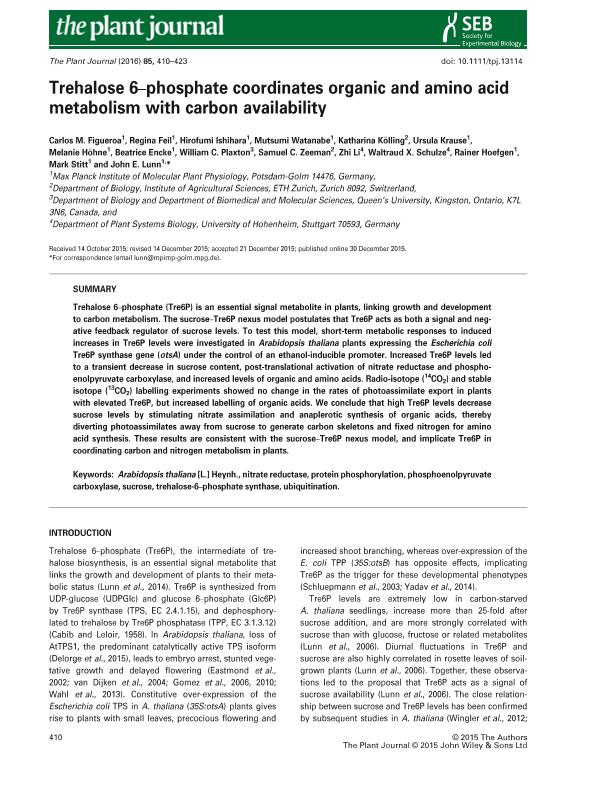Mostrar el registro sencillo del ítem
dc.contributor.author
Figueroa, Carlos Maria

dc.contributor.author
Feil, Regina
dc.contributor.author
Ishihara, Hirofumi
dc.contributor.author
Watanabe, Mutsumi
dc.contributor.author
Kölling, Katharina
dc.contributor.author
Krause, Ursula
dc.contributor.author
Höhne, Melanie
dc.contributor.author
Encke, Beatrice
dc.contributor.author
Plaxton, William C.
dc.contributor.author
Zeeman, Samuel C.
dc.contributor.author
Li, Zhi
dc.contributor.author
Schulze, Waltraud X.
dc.contributor.author
Hoefgen, Rainer
dc.contributor.author
Stitt, Mark
dc.contributor.author
Lunn, John E.
dc.date.available
2018-05-16T19:25:49Z
dc.date.issued
2016-02
dc.identifier.citation
Figueroa, Carlos Maria; Feil, Regina; Ishihara, Hirofumi; Watanabe, Mutsumi; Kölling, Katharina; et al.; Trehalose 6-phosphate coordinates organic and amino acid metabolism with carbon availability; Wiley Blackwell Publishing, Inc; Plant Journal; 85; 3; 2-2016; 410-423
dc.identifier.issn
0960-7412
dc.identifier.uri
http://hdl.handle.net/11336/45420
dc.description.abstract
Trehalose 6-phosphate (Tre6P) is an essential signal metabolite in plants, linking growth and development to carbon metabolism. The sucrose-Tre6P nexus model postulates that Tre6P acts as both a signal and negative feedback regulator of sucrose levels. To test this model, short-term metabolic responses to induced increases in Tre6P levels were investigated in Arabidopsis thaliana plants expressing the Escherichia coli Tre6P synthase (otsA) under the control of an ethanol-inducible promoter. Increased Tre6P led to a transient drop in sucrose content, post-translational activation of nitrate reductase and phosphoenolpyruvate carboxylase, and increased levels of organic and amino acids. Radio- (14CO2) and stable-isotope (13CO2) labelling experiments showed no change in the rates of photoassimilate export in plants with elevated Tre6P, but increased flux of carbon into organic acids. It is concluded that high Tre6P lowers sucrose levels by stimulating nitrate assimilation and anaplerotic synthesis of organic acids, thereby diverting photoassimilates away from sucrose to generate carbon skeletons and fixed nitrogen for amino acid synthesis. These results are consistent with the sucrose-Tre6P nexus model and implicate Tre6P in coordinating carbon and nitrogen metabolism in plants.
dc.format
application/pdf
dc.language.iso
eng
dc.publisher
Wiley Blackwell Publishing, Inc

dc.rights
info:eu-repo/semantics/openAccess
dc.rights
Atribución-NoComercial-CompartirIgual 2.5 Argentina (CC BY-NC-SA 2.5 AR)
dc.rights.uri
https://creativecommons.org/licenses/by-nc-sa/2.5/ar/
dc.subject
Arabidopsis Thaliana
dc.subject
Nitrate Reductase
dc.subject
Protein Phosphorylation
dc.subject
Phosphoenolpyruvate Carboxylase
dc.subject
Sucrose
dc.subject
Trehalose-6-Phosphate Synthase
dc.subject
Ubiquitination
dc.subject.classification
Otras Ciencias Biológicas

dc.subject.classification
Ciencias Biológicas

dc.subject.classification
CIENCIAS NATURALES Y EXACTAS

dc.title
Trehalose 6-phosphate coordinates organic and amino acid metabolism with carbon availability
dc.type
info:eu-repo/semantics/article
dc.type
info:ar-repo/semantics/artículo
dc.type
info:eu-repo/semantics/publishedVersion
dc.date.updated
2018-05-11T21:16:56Z
dc.journal.volume
85
dc.journal.number
3
dc.journal.pagination
410-423
dc.journal.pais
Reino Unido

dc.journal.ciudad
Londres
dc.description.fil
Fil: Figueroa, Carlos Maria. Consejo Nacional de Investigaciones Científicas y Técnicas. Centro Científico Tecnológico Conicet - Santa Fe. Instituto de Agrobiotecnología del Litoral. Universidad Nacional del Litoral. Instituto de Agrobiotecnología del Litoral; Argentina
dc.description.fil
Fil: Feil, Regina. Max Planck Institute of Molecular Plant Physiology; Alemania
dc.description.fil
Fil: Ishihara, Hirofumi. Max Planck Institute of Molecular Plant Physiology; Alemania
dc.description.fil
Fil: Watanabe, Mutsumi. Max Planck Institute of Molecular Plant Physiology; Alemania
dc.description.fil
Fil: Kölling, Katharina. Institute of Agricultural Sciences; Suiza
dc.description.fil
Fil: Krause, Ursula. Max Planck Institute of Molecular Plant Physiology; Alemania
dc.description.fil
Fil: Höhne, Melanie. Max Planck Institute of Molecular Plant Physiology; Alemania
dc.description.fil
Fil: Encke, Beatrice. Max Planck Institute of Molecular Plant Physiology; Alemania
dc.description.fil
Fil: Plaxton, William C.. Queens University; Canadá
dc.description.fil
Fil: Zeeman, Samuel C.. Institute of Agricultural Sciences; Suiza
dc.description.fil
Fil: Li, Zhi. Universidad de Hohenheim; Alemania
dc.description.fil
Fil: Schulze, Waltraud X.. Universidad de Hohenheim; Alemania
dc.description.fil
Fil: Hoefgen, Rainer. Max Planck Institute of Molecular Plant Physiology; Alemania
dc.description.fil
Fil: Stitt, Mark. Max Planck Institute of Molecular Plant Physiology; Alemania
dc.description.fil
Fil: Lunn, John E.. Max Planck Institute of Molecular Plant Physiology; Alemania
dc.journal.title
Plant Journal

dc.relation.alternativeid
info:eu-repo/semantics/altIdentifier/doi/http://dx.doi.org/10.1111/tpj.13114
dc.relation.alternativeid
info:eu-repo/semantics/altIdentifier/url/https://onlinelibrary.wiley.com/doi/abs/10.1111/tpj.13114
Archivos asociados
